Garden designs for summer houses
Inspiration, ideas, layouts and garden designs for different summer houses
GardenLife summer houses, log cabins, pavilions and garden rooms can really enhance the design of a garden, not to mention provide another room to expand into. Whether you need a place to work, excercise, relax or enjoy a hobby, a real wood garden building could be the perfect solution.
With a little thought, inspiration and careful planning, you can also use your summer house to dramatically change the look and feel of your garden by adding character, height, colour and texture, as well as creating a lovely private haven. Here are a few ideas for different shaped summer houses and gardens layouts for you to consider.
![]()
Traditional corner summer house layout
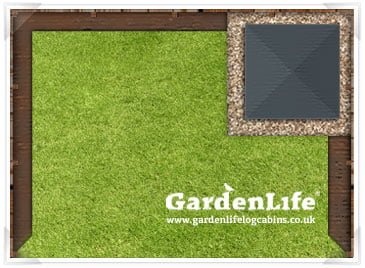
Our timber corner summer houses are designed specifically for small gardens where space is at a premium. Designed to fit neatly into a corner (with the windows facing out into the garden), our corner summer houses range in size from the highly compact Melanie (6.8 sqm) to the more sizeable Melanie (9.6 sqm). We also have corner units that include separate storage areas, such as Melanie (10.7 sqm), and Melanie (6.8 + 8.3 sqm) (and the latter also features a large roof overhang and covered area).
Corner summer house with decking area
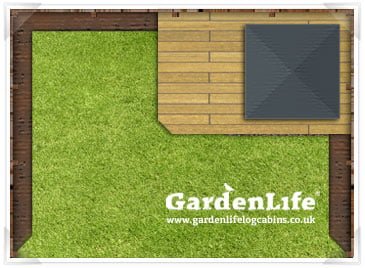
When you build a summer house in your garden you have to consider a firm base or foundation. You’ll need to spend a fair amount on either concrete or decking, so you might want to consider making the most of the decking and making the base larger than the footprint of the summer house. An interestingly shaped decking area, with space to sit out on furniture or a swing seat, or gather around a fire pit or barbeque, can turn a simple corner summer house into a complete recreational area.
Traditional rectangular summer house plan
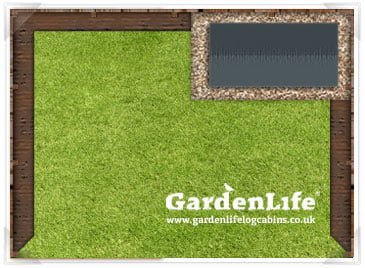
We have a range of rectangular shaped summer houses that feature windows running along the front, and sometimes one or both sides. From the compact and traditional looking Claudia (7.4 sqm) clockhouse, to the larger modern looking models such as Iris (9.6 sqm) and Lisa (11.5 sqm). All these summer rooms are ideally suited to running along the back fence of a garden, with the windows looking out into the garden. Many of our summer houses can be built in reverse, so if our product photo shows a door to the left and and a window to the right, these can easily be switched around to suit your garden plan.
Angled summer house with storage area
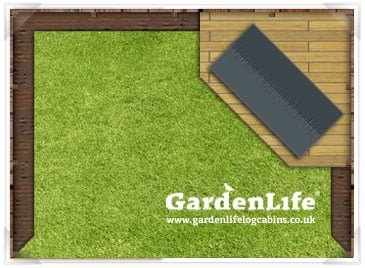
If you have limited space in your garden and would like a more spacious rectangular summer house and a storage area, you could consider a garden design similar to the plan above. Adding a summer house at an angle can alter the look and feel of the garden, create different areas for bedding plants and tree planting, as well as providing a hidden zone behind the building. You might want to consider positioning a rectangular summer house across the corner of your garden if you want a sheltered area to sit in, a more private barbecue area, or simply some space to store garden tools, toys and furniture.
Plan for a long garden with a summer house

A lot of gardens in the UK, particularly in more historic cities and market towns, are long and narrow. Typical of the Victorian era, these thin gardens normally feature beds down either side, or they are split into sections. A small corner summer house (as mentioned above) may be a good option if you don’t want to eat into the overall space, or block the view along the garden. However, a wide rectangular summer house placed along the end of the garden can act as a great focal point. The cost effective Lisa (11.5 sqm), the slightly larger Lisa (14.2 sqm) or the sizeable Lisa (19.4 sqm) are all modern summer houses ideal for the end of a narrow garden.
Summer house, decking and storage options
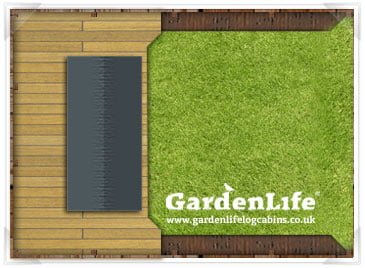
Adding a timber summer house to a long thin garden doesn’t mean that you have to position it along the back fence, there are quite a few options available. You could consider using a wide summer house to effectively split your garden in two, placing it in the middle of your plan, creating a secret planting area behind the building. Alternatively, if you are using decking as a base, the summer house could be positioned towards the end of the garden with the decking surrounding it (as above). This type of design acts as a focal point, but also allows for a quiet retreat, a shaded area for lounging, a private barbecue area or space for garden storage.
Typical pavilion summer house placement
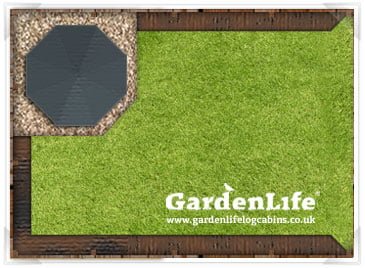
We often receive customer photos of our timber pavilions and they tend to be placed in the corner of the garden, either on a concrete base surrounded by plants, or raised on decking with space for seats. The traditional octagonal Veronica (6.7 sqm) pavilion, the hexagonal Hanna (7.6 sqm) pavilion and the larger octagonal Veronica (9.2 sqm) timber pavilion are all perfect for corner placement, affording views around the whole garden (and all under £3500 as well). Our Scandinavian style barbecue huts are also perfect for the corner of a garden. Eva (8.7 sqm) and the more substantial Eva (11.4 sqm) are ideal for barbecue lovers.
Central garden pavilion & focal point
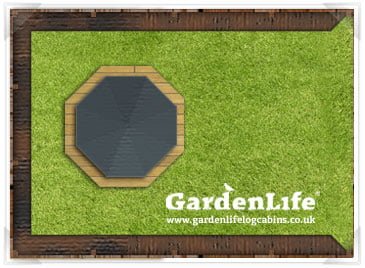
Because our summer house pavilions feature such beautiful traditional designs, you can really make them the focal point of your garden, designing the shape of your beds and the position of newly planted trees around them. Alternatively, you could place the octagonal Veronica (9.2 sqm) timber pavilion in the centre of your lawn (as above), raised up on decking, and opt for the Extra model – this comes with seven windows, allowing 360° views of your garden. Instead, the traditional Hanna (14.1 sqm) pavilion offers elegance, style and substantial space, and would make a stunning focal point.
Garden design tips for summer houses
Before buying a garden building we always recommend reading through our buyers guide to garden buildings and our timber wall thickness guide, plus we’d always advise having a chat with us too. When you’ve chosen your summer house and come to plan your garden design, try to bear in mind the following points:
- Even if your summer house is under 2.5m high always check local planning permission.
- If local planning laws allow you to position your summer house next to a boundary, always check with your neighbours first.
- To allow for water run-off, drainage, and access for maintenance, always leave least 0.5m (2-3 feet) of free space around the walls of the summer house.
- Be careful not to position the summerhouse on top of exposed tree roots, or where overhanging branches could cause damage.
- Consider the movement of the sun throughout the year and position your summer house to catch either the early morning, or late evening sun (unless of course you want more shade from the sun).
- If you live in an exposed spot (where high winds are common) consider some form of wind protection around the summer house (such as trellis or hedging).
- Be creative, summer houses don’t always have to be positioned in the corner of the garden, they can be used to create zones, form a private area, act as a focal point or a foil for a storage area.
- If you can’t get your creative juices flowing visit some local gardens to get inspiration, or have a look at some gardening websites, such as the RHS, Great British Gardens, The Lost Gardens of Heligan, NGS and Kew Royal Botanic Gardens.
10% off the RRP
Check out our garden building sale - there are big savings on garden rooms, summer houses and log cabins!
GardenLife news
Keep up to speed with helpful gardening guides, outdoor living suggestions and the latest product news
Summer house paint colours
Summer house paint colours Our top summer house colour schemes with real customer photos Asking "what colour should I paint my summer house?" - Here are our ideas Choosing the right colour to paint your much loved summer house can be problematic. The last thing you...
Sustainable garden design – 15 quick tips
Sustainable garden design - 15 quick and essential tips It's odd to think that a garden may not be an environmentally-friendly or natural place. Most have a lawn, greenery and some trees. However, these days it is often normal for paving slabs, non-native species,...
Gardening, therapy and mental health
Gardening, therapy and mental health Have you noticed how people are talking about gardening, therapy and mental health recently? ‘Horticulture therapy’, as some people call it, is an increasingly popular prescription for everything from depression and anxiety to...






